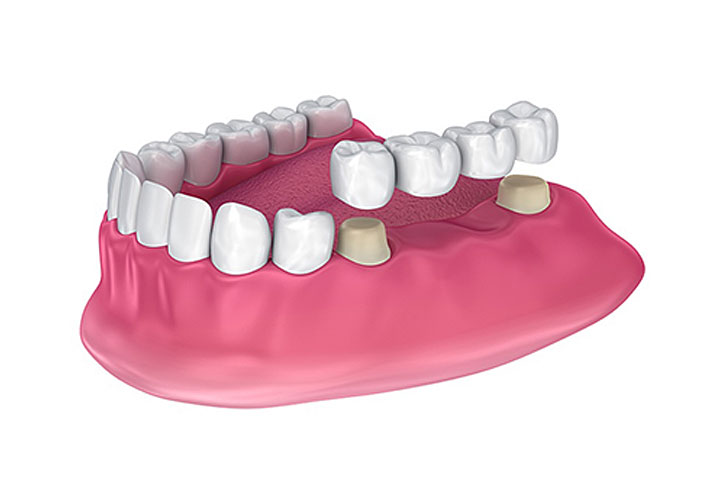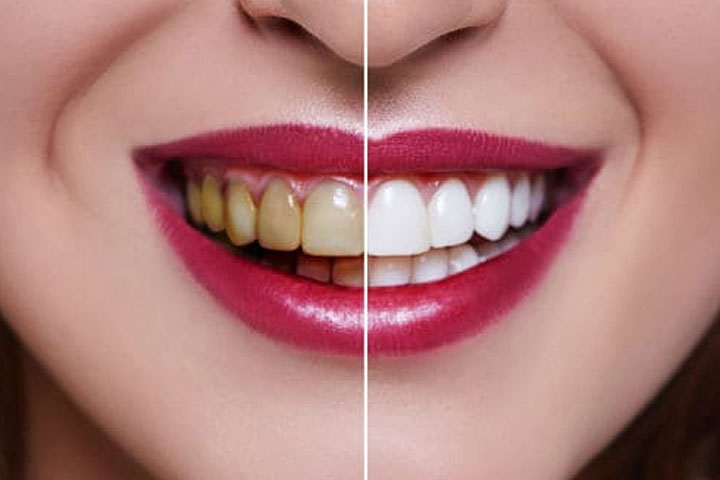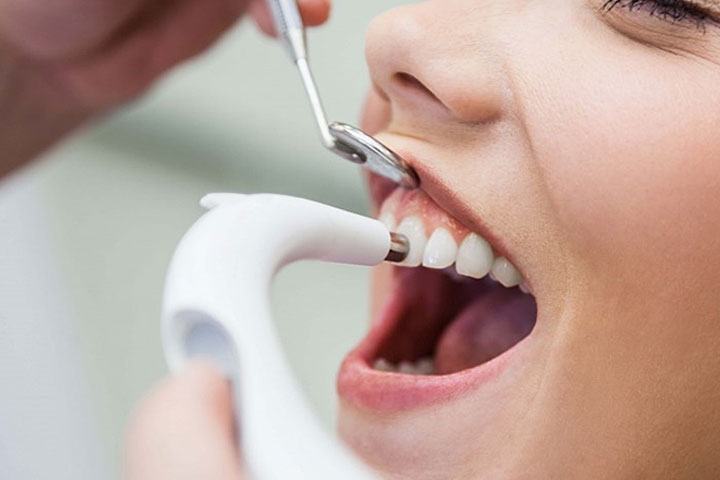
Crowns and Bridges
When a tooth is chipped, broken or removed, it becomes imperative to protect it or replace it in order to maintain a good bite, stable health of the adjacent teeth and good aesthetics.Importance Of Crown and Bridge Restorations
Teeth work together. When one tooth is badly broken, fractured, or missing, this can damage the remaining teeth and surrounding tissues as explained below:
- The remaining teeth shift or migrate, leading to a poor bite and improper chewing, and eventual joint pain.
- Shifting of teeth also leads to poor oral hygiene, causing teeth to decay and gum infection.
- Poor aesthetics.
- Crown and bridge restorations should be done to repair teeth and replace missing teeth and thus maintain a healthy, attractive mouth.

Understanding Crown and Bridges
- Crown: A crown is a cap that covers the entire tooth to restore it to proper function and aesthetics. It can be made of acrylic, metal, ceramic or zirconia. To fit a crown the tooth needs to be shaped. Crowns are either cemented or bonded onto the teeth.
- Bridge: A bridge replaces one or more missing teeth. The teeth adjacent to the missing tooth are crowned and an artificial tooth bridges the gap. Depending on the position and number of missing teeth, the number of supporting teeth will vary.
- Temporary Bridge: A permanent bridge can take between 2-10 days to be made. In the interim, a temporary bridge is sometimes placed, to facilitate chewing and maintain aesthetics. The temporary bridge is cemented with temporary cement.

Care For Your Crown and Bridge
Once you are happy with your restoration, remember to look after it well.
- Brush and floss as you regularly do.
- Regular checkups ensure you get the best out of your restoration.

Veneers
Porcelain Veneers for Smile Makeovers
Dental veneers have long been used to create the ultimate smile makeover. With this treatment, it’s possible to transform crooked, stained, damaged, or badly worn teeth into a brand new, straight, white smile, as seen on many of the Hollywood greats.
So what exactly are dental veneers?
Veneers are wafer-thin laminates or shells of tooth-colored material (which can be either porcelain, ceramic or composite bonding material). They are “cemented” to the front surface of teeth to improve their cosmetic appearance. Many dentists use the analogy that dental veneers are for your teeth what false fingernails are for your hands.
What treatments or problems are veneers used for?
There are a wide variety of reasons why patients opt for treatment with dental veneers:
- Stained teeth – badly stained teeth that cannot be improved by teeth whitening or prophyflex treatments can be greatly improved by dental veneers, which function to cover any existing stains on your teeth
- Damaged teeth – teeth that have become badly worn through excessive grinding or by carbonated drinks, as well as those that have been chipped or broken, can benefit from veneers. A small chip on a tooth can quickly be repaired with composite bonding, also knows as “composite veneers”. A single damaged tooth can easily be repaired with a porcelain veneer that has the same characteristics and color as your natural teeth.
- Gaps – spaces or(diastemas) between your teeth can easily be closed using dental veneers, giving you a more uniform looking smile.
- Crooked teeth – Veneers are not the ideal treatment for crooked teeth, and from the point of view of preserving your natural teeth structure, orthodontics or Invisalign braces would probably a better solution. However, such treatments can take up to a year or longer. For teeth that are not severely crooked, veneers placed over their front surface will give a straight and perfectly aligned-looking smile. For this type of treatment, many people refer to veneers as “instant orthodontics”, as you get a similar end result in a fraction of the time.
So which are better: composite veneers or porcelain veneers?
The most popular type of veneer is porcelain, which offers a stronger and more durable alternative to its composite counterpart. Composite veneers are also more prone to staining and do not last as long as porcelain veneers. Porcelain veneers also offer a more natural-looking, translucent appearance. Composite veneers are much cheaper than porcelain veneers in general, but considering that they do not last as long and need replacing more often, they could end up costing more in the long run. Composite work is ideal for small chips, as this treatment preserves more of your natural tooth structure.
How long do dental veneers last?
Porcelain veneers will typically last between five and ten years, while composite veneers last a year or two at most. The bottom line is that your veneers will eventually need to be replaced. Although veneers are strongly cemented into place, there have been cases where they come loose and fall off. In such situations, it is important that you keep hold of your veneer and contact your dentist immediately. To make your veneers last longer, follow a good oral hygiene program and visit your dentist for check-ups on a regular basis.
What is the procedure of having dental veneers fitted?
- The first part of any dental procedure is the initial consultation and examination so that the dentist can get a feel for what you want and understand your needs and concerns. The dentist should explain the treatment procedure to you and give you an accurate guide to the likely costs of your treatment.
- Before your veneers are designed, your dentist will need to reshape and prepare the front surfaces of your teeth so that they can accommodate the veneers. The first stage is to numb the teeth and gums with a local anesthetic so that you do not feel anything during the procedure.
- Using a special tool called a burr (a dental drill or file), a tiny part of the front surface of your teeth will be shaved off. The amount removed should be equivalent to the thickness of the veneer that will sit over the top of the tooth. Next, an impression or mould (copy) of your teeth is taken. A special dental “putty” is placed into your mouth on a tray and pushed into your teeth so that it takes an imprint of your teeth (similar to how you would leave a footprint in sand).
- This “impression” or mould of your teeth is then sent to a dental laboratory. The laboratory uses the impression to cast an accurate model of your teeth, which is used as a guide to fabricate your new veneers. This process can take between one and three weeks.
- While you’re waiting for your veneers to be fabricated, your dentist may fit you with some temporary veneers to protect your prepared teeth. Not all dentists will offer temporary veneers.
- On your second appointment, your dentist will fit your new veneers into your teeth. First, the dentist may just sit the veneers over your teeth to see how they look with your smile, as he/she may need to trim or adjust the veneer.
- Next, your teeth will be thoroughly cleaned and the front surfaces etched (roughened) with a special acid gel so that they provide a good surface for the dental cement to stick to.
- The veneers are then cemented into place, and a special curing light is used to activate the dental cement so that it permanently bonds the veneer to the front surface of your prepared tooth. If there is any excess cement, it is usually trimmed away and polished to leave a beautiful and natural-looking restoration.



